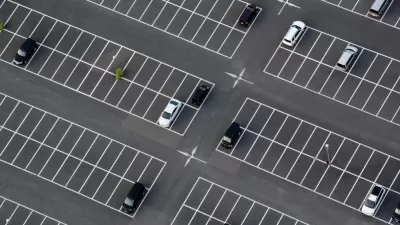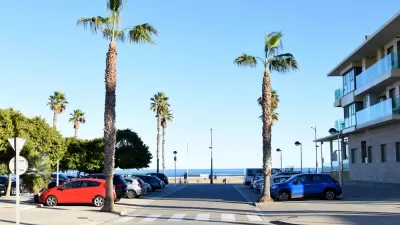More cities and states are recognizing the harmful impacts of minimum parking requirements, which in many cases have accelerated sprawl and raised the cost of housing construction.

California’s recent decision to eliminate parking requirements at developments near public transit could have a major impact on the country’s parking lot ‘addiction,’ writes Ciara Nugent in Time. “The move will encourage developers to build more affordable homes for people who don’t want a parking space, and generate ‘more walkable neighborhoods and public transit,’ [California Governor] Newsom said.”
According to Nugent, “The shift is heartening for climate advocates who believe redesigning cities and how people move around them must be a critical part of the country’s efforts to reduce its outsize greenhouse gas emissions from cars.” The law doesn’t bar developers from building as much parking as demand calls for, but prevents cities from maintaining often exaggerated requirements that drive up building costs.
The article details the history of minimum parking requirements, which began as a reaction to the sudden influx of automobiles to cities as the invention became more affordable. “As more people bought cars, a self-fulfilling cycle set in: cities started to separate districts by use, assuming everyone can drive from their residential area to their shopping area to their office. Large highways began to cut through town centers, making it harder to cycle or walk.”
Today, the tide is slowly turning against parking as cities and states eliminate parking minimums, invest in public transit and other multimodal infrastructure, and encourage developers to build denser, more transit-oriented development that reduces the American overreliance on cars.
FULL STORY: Americans' Addiction to Parking Lots Is Bad for the Climate. California Wants to End It

Alabama: Trump Terminates Settlements for Black Communities Harmed By Raw Sewage
Trump deemed the landmark civil rights agreement “illegal DEI and environmental justice policy.”

Planetizen Federal Action Tracker
A weekly monitor of how Trump’s orders and actions are impacting planners and planning in America.

Why Should We Subsidize Public Transportation?
Many public transit agencies face financial stress due to rising costs, declining fare revenue, and declining subsidies. Transit advocates must provide a strong business case for increasing public transit funding.

Understanding Road Diets
An explainer from Momentum highlights the advantages of reducing vehicle lanes in favor of more bike, transit, and pedestrian infrastructure.

New California Law Regulates Warehouse Pollution
A new law tightens building and emissions regulations for large distribution warehouses to mitigate air pollution and traffic in surrounding communities.

Phoenix Announces Opening Date for Light Rail Extension
The South Central extension will connect South Phoenix to downtown and other major hubs starting on June 7.
Urban Design for Planners 1: Software Tools
This six-course series explores essential urban design concepts using open source software and equips planners with the tools they need to participate fully in the urban design process.
Planning for Universal Design
Learn the tools for implementing Universal Design in planning regulations.
Caltrans
Smith Gee Studio
Institute for Housing and Urban Development Studies (IHS)
City of Grandview
Harvard GSD Executive Education
Toledo-Lucas County Plan Commissions
Salt Lake City
NYU Wagner Graduate School of Public Service





























